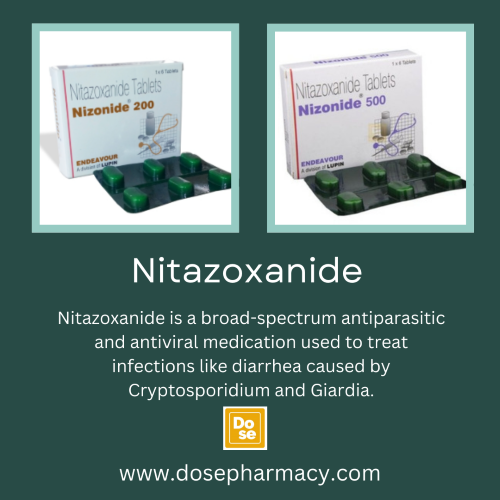
Nitazoxanide 500 mg is an antiparasitic and antiviral medication widely used to treat a variety of infections caused by protozoa and helminths. Originally developed for managing intestinal parasites, its broad-spectrum action has made it an effective choice for treating both common and rare parasitic infections. In this article, we will explore the different parasites that Nitazoxanide targets, its mechanism of action, and its role in modern medicine.
Understanding Nitazoxanide
Nitazoxanide 200 mg belongs to the thiazolide class of drugs and works by inhibiting anaerobic metabolism in certain parasites and bacteria. It disrupts the pyruvate-ferredoxin oxidoreductase (PFOR) enzyme-dependent electron transfer, which is essential for the energy metabolism of many parasites. This leads to the death of the parasite, effectively eliminating the infection.
Parasites Treated by Nitazoxanide
Nitazoxanide from Dose Pharmacy is effective against several types of protozoan and helminthic infections. The most commonly treated parasites include:
1. Giardia lamblia
- Infection: Giardiasis
- Symptoms: Diarrhea, bloating, stomach cramps, nausea, and fatigue
- How Nitazoxanide Helps: Giardia is a common protozoan that infects the intestines. Nitazoxanide works by preventing the parasite from metabolizing energy, leading to its death and elimination from the body.
2. Cryptosporidium parvum
- Infection: Cryptosporidiosis
- Symptoms: Watery diarrhea, nausea, vomiting, fever, and weight loss
- How Nitazoxanide Helps: Cryptosporidiosis is a serious concern, especially for immunocompromised individuals. Nitazoxanide is one of the few FDA-approved treatments for this infection, helping to reduce symptom severity and duration.
3. Entamoeba histolytica
- Infection: Amoebiasis
- Symptoms: Bloody diarrhea, abdominal pain, fever, and liver abscesses in severe cases
- How Nitazoxanide Helps: It disrupts the metabolic pathways of Entamoeba histolytica, stopping its growth and reducing the severity of symptoms.
4. Helminths (Parasitic Worms)
Nitazoxanide also has activity against certain helminths, including:
- Ascaris lumbricoides (Roundworm): Causes ascariasis, leading to malnutrition, abdominal pain, and intestinal blockage.
- Trichuris trichiura (Whipworm): Causes trichuriasis, leading to diarrhea, anemia, and growth retardation in children.
- Ancylostoma duodenale and Necator americanus (Hookworms): These parasites lead to anemia, malnutrition, and developmental problems in children.
Nitazoxanide interferes with their metabolism, ultimately eliminating them from the digestive system.
Off-Label and Emerging Uses
Nitazoxanide has shown promise in treating other infections beyond its traditional use. Some of its off-label applications include:
1. Clostridium difficile-Associated Diarrhea
- Though primarily used for parasitic infections, Nitazoxanide has demonstrated effectiveness in treating Clostridium difficile, a bacterium that causes severe diarrhea.
2. Rotavirus and Norovirus
- Studies suggest Nitazoxanide can reduce the duration and severity of viral gastroenteritis caused by these viruses, especially in children.
3. Hepatitis B and C
- Some research indicates that Nitazoxanide may have antiviral properties against chronic hepatitis B and C, although further studies are needed.
Dosage and Administration
Nitazoxanide is typically administered orally in tablet or suspension form. The dosage depends on the patient’s age, weight, and infection type. The general guidelines include:
- For Giardia and Cryptosporidium: 500 mg twice daily for three days (adults)
- For children: Dosage is weight-dependent, with a standard regimen of 100-200 mg twice daily for three days.
Safety and Side Effects
Nitazoxanide is generally well-tolerated, but some individuals may experience mild side effects, including:
- Nausea
- Abdominal pain
- Diarrhea
- Headache
- Dizziness
Serious side effects are rare, but individuals with liver or kidney disorders should consult a healthcare provider before use.
Precautions and Contraindications
- Pregnancy and Breastfeeding: Limited data are available, so use during pregnancy and breastfeeding should be discussed with a doctor.
- Drug Interactions: Nitazoxanide may interact with other medications, including anticoagulants and immunosuppressants.
- Immunocompromised Patients: While effective, treatment may take longer or require additional management in individuals with weakened immune systems.
Nitazoxanide is a powerful antiparasitic medication used to treat a variety of intestinal parasites, including Giardia, Cryptosporidium, Entamoeba histolytica, and several helminths. Its broad-spectrum efficacy, combined with relatively mild side effects, makes it a preferred choice for many parasitic infections. Additionally, its potential role in treating viral infections and bacterial diarrhea continues to be explored in medical research. If you suspect a parasitic infection, consult a healthcare professional for appropriate diagnosis and treatment with Nitazoxanide.





Leave a Reply